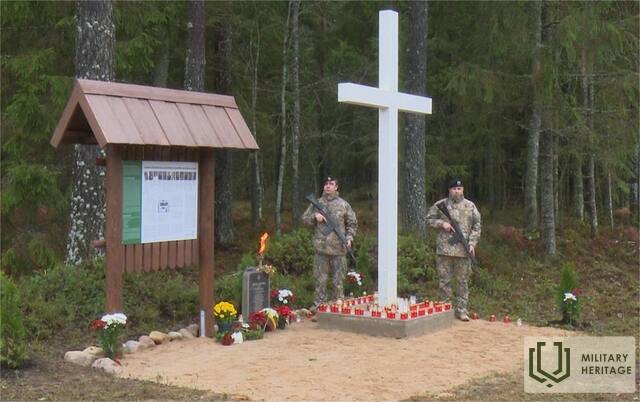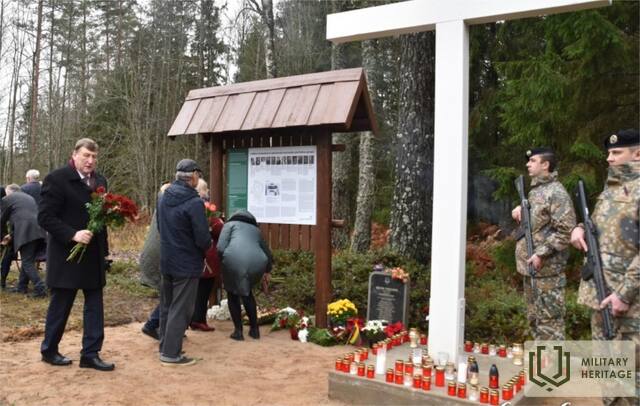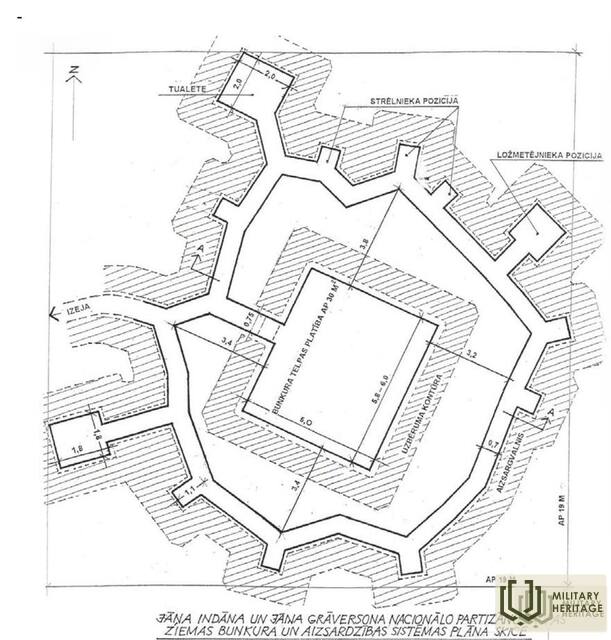Memorial site to the members of the J. Indāns - J. Grāvelsons and M. Pokļevinskis national partisan groups
Memorial site


 160
160



An information stand and memorial site for the Indāns - Grāvelsons national partisan group in Kalna parish, Jēkabpils region, in the vicinity of Sūpes purvas, was opened on Lāčplēsis Day - November 11, 2019. Representatives of Jēkabpils region and Viesīte region, former national partisan H. Miezīte, historian H. Bruņinieks, as well as guests from Lithuania and other interested parties participated in its opening. The memorial site and stand are located near Sūpes purvas, which is associated with the sites of national partisan settlements and battles. Deeper in the forest was also the bunker of the Indāns-Grāvelsons group.
After the deportations of the Latvian population on March 25, 1949, the national partisan supply system was destroyed. From the summer of 1949 to mid-1952, the national partisan movement in the Aknīste, Sauka, Elkšņi, Birži and Viesīte areas experienced its decline, as it suffered from ethnic cleansing and regular counterattacks by the Soviet army and security institutions. The settlement of the national partisan group of Jānis Indāns and Jānis Grāvelsons in the Elkšņi forest in the winter of 1949-1950 had a very serious defense system, uncharacteristic for that time, which did not exist anywhere else in Latvia or in its neighboring country Lithuania in the 1950s. The bunker of the Indāns-Grāvelsons group had specially created perimeter defense trenches and gun nests. Along with the partisans' military readiness to sacrifice their lives in the fight against the enemy, it is also possible to speak of their special identity, which was also manifested in the involvement of other family members in the ranks of the national partisans.
The Indāns-Grāvelsons joint partisan group consisted of 12 people, including five women and one Lithuanian partisan: Jānis Indāns, Jānis Edvards Grāvelsons, Alma Grāvelsone, Pēteris Indāns, Kristīne Indāne, Milda Ārija Indāne, Vasilijs Sokolovs, Voldemārs Otto Sātnieks, Jānis Ķepiņš, Hilda Vietniece, Artūrs Snikus, Jons Žukauskis. Their last battle took place on February 25, 1950, in the Elkšņu Forest, when 11 partisans fell in battle against disproportionately strong forces. Only Hilda Vietniece (Miezīte) survived, who was captured and later spent six years in prison in the Gulag camps.
Used sources and references:
H. Bruņinieks. Cheating Death. Riga: Latvian Media, 2022, pp. 232-236.
https://www.youtube.com/watch?v=TgP9yTWbD5g
https://latvijaspieminekli.lv/pieminas-vieta-indana-gravelsona-apvienotajai-nacionalo-partisanu-grupai/
https://www.jekabpilslaiks.lv/lv/zinas/jekabpils-novada-atklas-nacionalajiem-partizaniem-veltitu-pieminas-vietu/
Related timeline
Related stories
Selija's forest brother settlement in the Sūpe swamp
The Sūpes swamp is associated with the sites of national partisan settlements and battles, which were formed through the interaction of people and places. It is described in the ballad of the exiled Latvian writer Alberts Eglītis about the events in his native Sūpes swamp “In Moss and Mud” - a tribute to the Sūpes swamp partisans:
… “In 1945, as autumn glowed in the swamp -
On Pokļevinskis' birthday, Lieljānis shares at dinner:
Beer fermented in willows,
The Romulans worship butter,
I dry my mother's caraway bread,
Dried ham in March cuts,
And Stuchka's onions,
Ildzeniece cheese.
Rooms in resinous walls
And lightning has struck hearts,
And in eleven souls languish-
"The roots that have rotted in the ground..."
This interpretation of the past, with its post-World War II events, included human testimonies, expressions of spirit, and value systems. It recalls the popular support for the national partisans, whom the occupying power could not defeat so easily.








